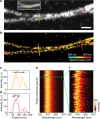Super-resolution spectroscopic microscopy via photon localization
- PMID: 27452975
- PMCID: PMC4962472
- DOI: 10.1038/ncomms12290
Super-resolution spectroscopic microscopy via photon localization
Abstract
Traditional photon localization microscopy analyses only the spatial distributions of photons emitted by individual molecules to reconstruct super-resolution optical images. Unfortunately, however, the highly valuable spectroscopic information from these photons have been overlooked. Here we report a spectroscopic photon localization microscopy that is capable of capturing the inherent spectroscopic signatures of photons from individual stochastic radiation events. Spectroscopic photon localization microscopy achieved higher spatial resolution than traditional photon localization microscopy through spectral discrimination to identify the photons emitted from individual molecules. As a result, we resolved two fluorescent molecules, which were 15 nm apart, with the corresponding spatial resolution of 10 nm-a four-fold improvement over photon localization microscopy. Using spectroscopic photon localization microscopy, we further demonstrated simultaneous multi-colour super-resolution imaging of microtubules and mitochondria in COS-7 cells and showed that background autofluorescence can be identified through its distinct emission spectra.
Conflict of interest statement
H.F.Z. and C.S. have financial interests in Opticent Health. V.B. has financial interests in NanoCytomics. Neither of these companies funded this work. All remaining authors declare no competing financial interests.
Figures




References
-
- Nie S. & Emory S. R. Probing single molecules and single nanoparticles by surface-enhanced raman scattering. Science 275, 1102–1106 (1997). - PubMed
-
- Zumbusch A., Holtom G. R. & Xie X. S. Three-dimensional vibrational imaging by coherent anti-Stokes Raman scattering. Phys. Rev. Lett. 82, 4142–4145 (1999).
-
- Weiss S. Measuring conformational dynamics of biomolecules by single molecule fluorescence spectroscopy. Nat. Struct. Biol. 7, 724–729 (2000). - PubMed
-
- van Oijen A. M. et al. Unraveling the electronic structure of individual photosynthetic pigment-protein complexes. Biophys. J. 80, 151a–151a (2001). - PubMed
-
- Moerner W. E. A dozen years of single-molecule spectroscopy in physics, chemistry, and biophysics. J. Phys. Chem. B 106, 910–927 (2002).
Publication types
MeSH terms
Grants and funding
LinkOut - more resources
Full Text Sources
Other Literature Sources
Research Materials

